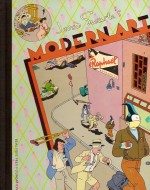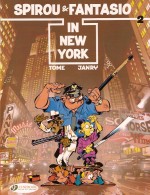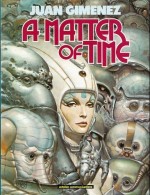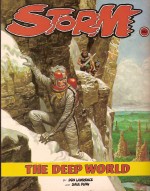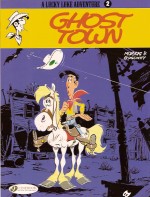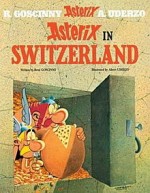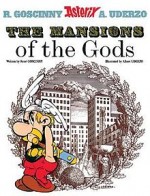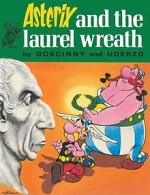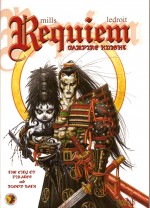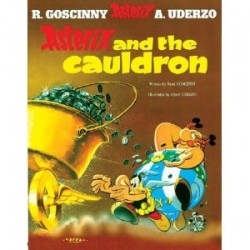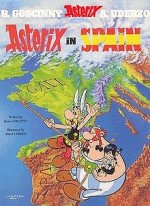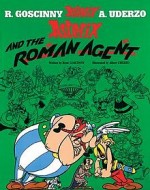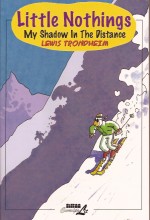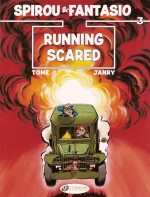
By Tome & Janry, translated by Jerome Saincantin (Cinebook)
ISBN: 978-1-84918-116-7
Spirou (whose name translates as both “squirrel†and “mischievous†in the Walloon language) was created by French cartoonist François Robert Velter AKA Rob-Vel for Belgian publisher Éditions Dupuis in response to the phenomenal success of Hergé’s Tintin for rival outfit Casterman.
An eponymous magazine was launched on April 21st 1938 with the other red-headed lad as the lead in an anthology weekly comic which bears his name to this day.
He began as a plucky Bellboy/lift operator employed by the Moustique Hotel (a reference to publisher’s premier periodical Le Moustique) whose improbable adventures with his pet squirrel Spip eventually evolved into high-flying surreal comedy dramas.
Spirou and his pals have spearheaded the magazine for most of its life, where a phalanx of truly impressive creators have carried on Velter’s work, beginning with his wife Blanche “Davine†Dumoulin who took over the strip when her husband enlisted in 1939.
She was aided by Belgian artist Luc Lafnet until 1943 when Dupuis purchased all rights to the feature, after which comic-strip prodigy Joseph Gillain (“Jijéâ€) took over, adding current co-star Fantasio to the mix. Along the way Spirou and Fantasio became globe-trotting journalists, continuing their weekly exploits in unbroken four-colour glory.
In 1946 Jijé‘s  assistant André Franquin assumed the reins, adding a spectacular popular magic animal dubbed Marsupilami to the cast (first seen in Spirou et les héritiers in 1952 and now a spin-off star of screen, plush toy store, console games and albums all his own), crafting increasingly fantastic tales until he resigned in 1969.
He was succeeded by Jean-Claude Fournier who updated the feature over the course of nine stirring adventures that tapped into the rebellious, relevant zeitgeist of the times with tales of environmental concern, nuclear energy, drug cartels and repressive regimes.
By the 1980s the series seemed outdated and without direction: three different creative teams alternated on the serial, until it was at last revitalised by the authors of the adventure under review here: Philippe Vandevelde writing as Tome and artist Jean-Richard Geurts best known as Janry.
These last adapted and referenced the beloved Franquin era, consequently reviving the feature’s fortunes and resulting in fourteen wonderful albums between 1984 and 1998. This one from 1988, originally entitled ‘La frousse aux trousses’ or ‘Fear on the Trail’, was their eighth and the 40th collection of the evergreen adventurers.
Harking back to the Fournier years, it comprises the first of an excellent extended two-part thriller which will conclude in Cinebook’s forthcoming ‘Valley of the Exiles’ (originally released as ‘La vallée des bannis’ or ‘Valley of the Banished’ in 1989).
Since Tome & Janry’s departure both Lewis Trondheim and the team of Jean-Davide Morvan & Jose-Luis Munuera have brought the official album count to fifty (there also are a bunch of specials, spin-offs and one-shots, official and otherwise)…
Running Scared opens with a frantic chase scene as Spirou races across the city in splendid breakneck tribute to the silent movies chases of Harold Lloyd and Buster Keaton. He’s late for a conference where he will recount his many harrowing career-related escapes and show films of his numerous close shaves…
Barely making it, he’s disappointed by the reaction of the audience: those that don’t faint dead away from fear flee the theatre in horror…
It’s a huge disappointment: the daring reporter was hoping to use the profits from his lecture tour to fund his upcoming expedition to discover the fate of two explorers who vanished in 1938 whilst attempting to climb a mountain and discover the legendary “Valley of Exiles†in the mysterious Himalayan nation of Yurmaheesun-shan…
Since 1950 the tiny country has been the subject of numerous invasions by rival super-powers and is a hotbed of rebellion, insurgency and civil war, but ever-undaunted Spirou and Fantasio were utterly determined to solve the ancient mystery.
Their plans are only temporarily derailed however. One of the fainters at the conference was the timid but esteemed Dr. Placebo: renowned authority on the medical condition Spasmodia Maligna and a man convinced that the only cure for the condition – prolonged, sustained and life-threatening synchronous diaphragmatic flutters (or hiccups to you and me) – is to be scared out of one’s wits.
Having seen Spirou in action Placebo wants the reporters to take his most chronic patients with them on this assignment and offers to fund the entire expedition to the war-torn jell-hole…
Over Fantasio’s cynical but sensible objection’s a deal is struck and soon the lads, Spip and five disparate, desperate hiccupping victims are sneaking across the Nepalese border where the diligent Captain Yi is tasked with keeping all foreigners – and especially western journalists – out of the country as it undergoes its pacification and re-education…
However, thanks to native translator Gorpah (a wily veteran guide who once proved invaluable to another red-headed reporter, his little white dog and a foul mouthed-sea captain) the daring band are soon deep in-country, but the invaders are quickly hot on the trail in tanks, armoured cars and attack helicopters, providing plenty of opportunities for the annoyingly obnoxious singultus flutterers to be terrified – but with little evidence of a cure…
And then just as they find their first real clue as to the location of the lost Valley of Exiles the explorers are captured by native partisans and rebels…
Even this doesn’t scare off any hiccups, nor does the daring later escape attempt masterminded by Spirou and Fantasio. As the liberated captives all pile into a lorry a huge storm breaks and the rebels give chase.
When one of their pursuer’s vehicles plunges over a cliff, the valiant fugitives frantically form a human chain to rescue the driver and in the horrendous conditions Spirou is washed away and lost in the raging torrent.
…And that’s when all the hiccupping finally stopped…
To Be Continued…
Starting in superb slapstick comedy mode and with gallons of gags throughout, Running Scared nevertheless quickly evolves into a dark-edged and cunningly shaded satirical critique of then current geo-political scandals like the Soviet invasion of Afghanistan and systematic eradication of Tibetan culture by the Chinese – which both of course still resonate in today’s world – as it unfolds an epic and utterly compelling rollercoaster of fun and thrills.
This kind of lightly-barbed, real-world adventure comedy-thriller is a sheer joy in an arena far too full of adults-only carnage, testosterone-fuelled breast-beating, teen-romance monsters or sickly sweet fantasy. Easily accessible to readers of all ages and drawn with all the beguiling style and seductive but wholesome élan which makes Asterix, Lucky Luke, The Bluecoats and Iznogoud so compelling, this is another cracking read from a long line of superb exploits, certain to be as much a household name as those series – and even that other kid with the white dog…
Original edition © Dupuis, 1988 by Tome & Janry. All rights reserved. English translation 2012 © Cinebook Ltd.

